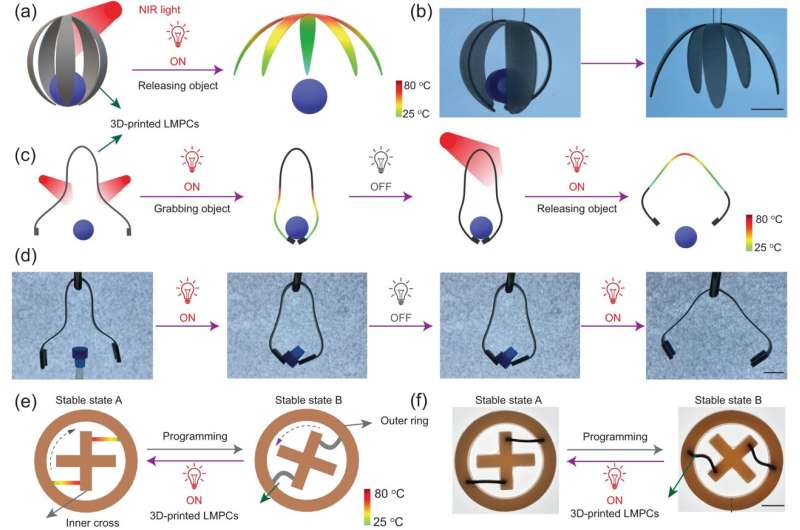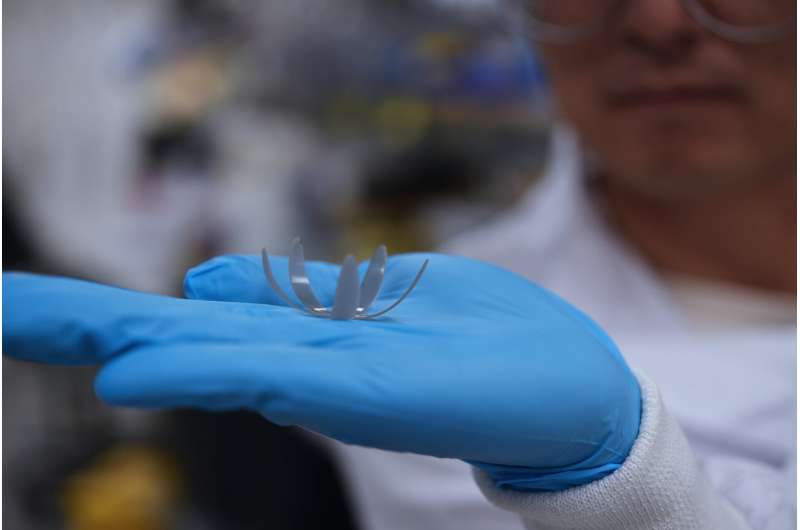This article has been reviewed according to Science X's editorial process and policies. Editors have highlighted the following attributes while ensuring the content's credibility:
fact-checked
peer-reviewed publication
proofread
Laser-controlled liquid metals herald new era for soft robotics

Researchers at The University of Queensland (UQ) are developing new 4D printing technology that produces shape-shifting liquid metals for soft robotics.
4D printing is an extension of 3D printing, where solid objects are created using materials that can change shape when exposed to certain stimuli like heat, water or light.
At UQ's Australian Institute for Bioengineering and Nanotechnology (AIBN), researchers are printing 4D structures using new liquid metal polymers that can be coaxed into performing a range of mechanical tasks with infrared lasers.
Lead researchers Dr. Liwen Zhang and Dr. Ruirui Qiao said the unique preparation methods developed by their lab allow them to produce 4D designs that are solid and durable while also being able to bend, grasp, lift, and release items five times their weight, or revert to a pre-programmed shape.
"4D printing takes traditional 3D printing and adds a new dimension—the dimension of time," Dr. Zhang said. "Our method allows us to produce smart liquid metals that can be customized, shaped and prompted to change over time without needing wires or circuits.
"This is a new era for robotics applications and a game-changer for additive manufacturing."
4D printed objects are usually prepared with a 3D printer using specific ingredients that give the finished product new qualities and abilities.
In their article published in the journal Nature Communications, Dr. Zhang, Dr. Qiao, and colleague Professor Tom Davis detail how they used spherical liquid metal nanoparticles to prepare printing resins that are responsive to near-infrared light, which means lasers can be used to guide the materials to bend, grab and release items.
While the technology is in its early stages, Dr. Qiao there was great potential to use it in the design of soft robotics, or technologies that mimic natural movements and interactions.
This could mean a number of applications across the aeronautical engineering and medical device sector, including coronary stents, artificial muscles, and other devices that adapt and change shape inside the body.
More broadly, Dr. Qiao said the ability to customize and shape materials after they had been printed would lead to wider manufacturing breakthroughs and consumer innovations, from climate-reactive clothes and building materials to self-assembling furniture.

"4D printing is a rapidly evolving field that is really only limited by imagination," Dr. Qiao said.
"The specific nanoparticles we use allow our materials react to lasers. Other 4D printed materials contain ingredients that react to water, heat, acid, electric, or magnetic energy.
"The early signs for this technology are incredibly promising, and the wide range of potential applications give us encouragement to continue our research."
More information: Liwen Zhang et al, 3D-printed liquid metal polymer composites as NIR-responsive 4D printing soft robot, Nature Communications (2023). DOI: 10.1038/s41467-023-43667-4




















